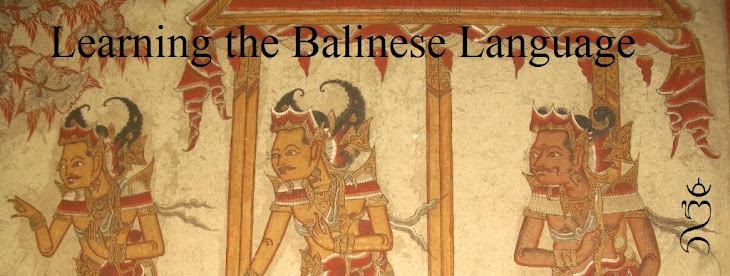This is a photo that I found on Wikipedia with the description Potret dua gadis penari Bali Portrait of two young Balinese dancers. If possible, I would like to add many photos and perhaps some videos also here to liven my blog up! If I only have article after article, I suppose everyone will be very bored, even me. Yeah, I have to find some photos and videos. If you have any photos that you would like to share with me, let me know.

Here are a few review sentences from my first lesson. The first group I will give in both Bahasa Indonesia and English. I realized that for me I should change the order of the translations. In my previous post, I gave the sentences and vocabulary in this order Alus - Bahasa Indonesia - English, but after trying to study the material, it seems to work better for me to first give the English so that I can try to get a mental image first of what I am about to say, followed by the Bahasa Indonesa so that I still have the image and now the new grammar, finally followed by the Basa Bali which basically shares the same grammar as Indonesian but substituting new vocabulary. In the first group that follows I won't give the English on purpose, trying to force myself or if anyone else who comes by here to think in Indonesian or Balinese. The second group will be only in Balinese. I am making up these sentences by my own and there may very well be some mistakes. If you understand basa Bali and you find a mistake, please let me know.
Bahasa Indonesia - Alus
Boleh saya bertanya? - Dados tiang matakén?
Dari mana Anda? - Saking napi jeroné?
Saya dari New York di Amérika. - Tiang saking New York ring Amérika.
Saya tinggal di Kuta. - Tiang meneng ring Kuta.
Bisa saya tahu nama Anda? - Dados uningin parabé?
Nama saya Polos. - Parab tiangé Polos.
Anda siapa? - Sira parab jeroné?
Nama saya Hendra. - Wastan tiangé Hendra.
Saya guru. - Tiang dados guru.
Saya mahasiswa. - Tiang dados mahasiswa.
Mau ke mana Anda? - Jagi kija?
Saya main-main. - Tiang malelancaran.
This second group will be only in Balinese. I am making up these sentences by my own and there may very well be some mistakes. If you understand basa Bali and you find a mistake, please let me know, because I would appreciate your help tremendously. The following sentences might be easier to understand because I will use the same sentence pattern filling in new vocabulary.
Alus
Tiang saking New York.
Tiang saking Fukuoka.
Tiang saking Denpasar.
Tiang saking Amérika.
Tiang saking Jepang.
Tiang saking Bali.
Tiang saking Australia.
Tiang saking Kanada.
Tiang saking Jerman.
Tiang saking Perancis.
Tiang meneng ring Sanur.
Tiang meneng ring Ubud.
Tiang meneng ring Nusa Dua.
Tiang meneng ring Jimbaran.
Tiang meneng ring Denpasar.
Tiang meneng ring Legian.
Tiang meneng ring Seminyak.
Tiang meneng ring Candidasa.
Tiang meneng ring Lovina.
Tiang meneng ring Semarapura.
Parab tiangé ʻAnalū.
Parab tiangé Hendra.
Parab tiangé Wayan.
Parab tiangé Madé.
Parab tiangé Nyoman.
Parab tiangé Ketut.
Parab tiangé Komang.
Parab tiangé Putu.
Parab tiangé Gedé.
Parab tiangé Adé.
Salam.






